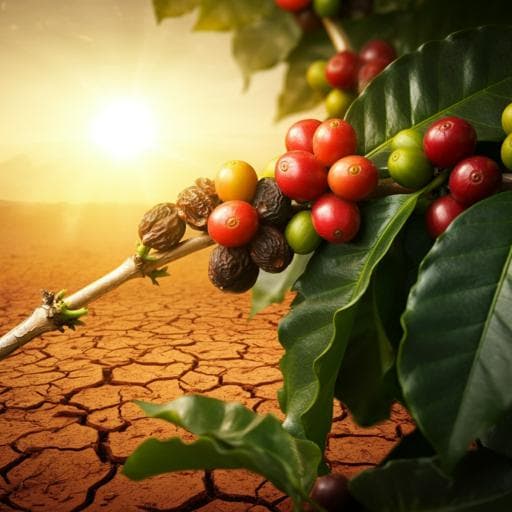
Agriculture
Impact of drought associated with high temperatures on *Coffea canephora* plantations: a case study in Espírito Santo State, Brazil
L. P. Venancio, R. Filgueiras, et al.
Explore the urgent findings of this study by Luan Peroni Venancio and colleagues, which reveals how droughts and soaring temperatures are crippling *Coffea canephora* plantations in Brazil. Discover critical vulnerabilities in crop cycles, the impact of climatic changes on production, and innovative strategies for mitigation.
~3 min • Beginner • English
Introduction
The study addresses how drought combined with high temperatures and irradiance impacts Coffea canephora (conilon coffee) production in Espírito Santo, Brazil—a region that supplies 70% of Brazil’s C. canephora and ~15% of global production. Coffee is highly vulnerable to climate variability; drought can reduce yields up to 80% in marginal, non-irrigated regions, and rising temperatures and altered precipitation patterns threaten suitability. Projections suggest C. canephora could lose ~55% of currently suitable areas, including in southeast Brazil. Espírito Santo’s coffee sector contributes ~35% of the state GDP and about 250,000 jobs, so climate-driven production shocks have major socio-economic implications. The research objective is to quantify and interpret the impacts of drought and high temperatures on production and yield across nine key municipalities in northern, northeastern and northwestern Espírito Santo from 2010–2016, identify sensitive crop-cycle periods to water stress, and inform adaptation strategies.
Literature Review
Prior works show drought reduces net carbon assimilation, stomatal conductance, carbohydrate reserves, and growth in C. canephora, even in drought-tolerant genotypes; water-use efficiency gains under drought can elevate leaf temperatures and further stress plants under warming. High temperatures impair photosynthesis and can cause flower abortion and grain wilting, particularly when combined with drought and high irradiance. Agroforestry systems mitigate microclimate extremes, increase soil moisture and infiltration, and reduce maximum air temperature and PAR, improving resilience of coffee to climate variability. Studies indicate conilon plantations in Espírito Santo are predominantly irrigated, but water shortages during extended droughts can deplete irrigation sources. Saturating irradiance for robusta leaves (~522–612 µmol m⁻² s⁻¹) is far below midday field irradiance (~2000 µmol m⁻² s⁻¹), compounding stress during drought/heat. Temperature suitability ranges for C. canephora are debated; some zoning suggests 22.5–24 °C (Brazil), others 22–26 °C, while modeling in Southeast Asia suggested optimum below ~20.5 °C, underscoring regional variability and genotype differences. Increased vapor pressure deficit (VPD) with warming can strongly reduce canopy conductance, to which Coffea spp. are sensitive. Shade agroforestry and genotype selection (drought-resistant vs. plastic genotypes) are discussed as adaptation strategies.
Methodology
Study area: Nine major conilon-producing municipalities in Espírito Santo, Brazil: Boa Esperança, Pinheiros (north); Jaguaré, Linhares, Rio Bananal, São Mateus (northeast); Colatina, Nova Venécia, Vila Valério (northwest). The region is predominantly flat, highly mechanized, with >90% of coffee irrigated (drip, micro-sprinkler, center pivot, conventional sprinkler). Predominant soils are Oxisols (Latossolo Vermelho-Amarelo).
Data sources and period: 2010/2011 to 2015/2016 agricultural years. Production, yield, planted area: IBGE (municipal) and CONAB (state/national). Meteorology: AGRITEMPO (TRMM-derived rainfall 25×25 km, 30-day resolution; INMET stations). Monthly rainfall (mm) and air temperature (°C) were obtained; average temperature data were available for Linhares, Nova Venécia, and São Mateus only. Remote sensing: MODIS/Terra MOD13Q1 EVI (16-day composites, 250 m) via EMBRAPA MODIS; 144 images covering six seasons were downloaded and rescaled from 0–10000 to 0–1.
Phenological periods: EVI and climate were aggregated into three crop periods based on known drought sensitivities: P1 (Sep–Dec; low sieve classification risk), P2 (Jan–Mar; endosperm malformation risk), P3 (Apr–Aug; fruit drop risk).
Data processing and analyses: Descriptive statistics of rainfall, average temperature, yield, and planted area were computed per season. An identity test for regression models (ANOVA, p<0.05) compared annual variation in production vs. planted area to test whether production changes were driven by area changes. Scatter plots assessed relationships between annual accumulated rainfall (Sep–Aug) and yield, and between average annual air temperature and yield. Response surface methodology modeled combined effects of accumulated rainfall and mean air temperature on production for P1, P2, P3, and annual periods. Principal component analysis (PCA) evaluated which rainfall period (P1, P2, P3) most influenced yield. Spatial EVI maps and boxplots were generated for each period and season to detect spatial-temporal drought impacts.
Key Findings
- 2015/2016 was the most impacted season: annual rainfall 549.3 mm (about 40% below the six-season mean ~920 mm), production dropped 41% vs. previous harvest; April–August (P3) rainfall was only 76.1 mm vs. average 192.18 mm in other seasons.
- Temperature impacts: Low-yield seasons 2012/2013 and 2015/2016 had mean annual temperatures ~1 °C higher than previous seasons; 2015/2016 had the highest average annual temperature of the series (>26 °C). Temperature increases above ~25 °C were associated with yield declines.
- Rainfall–yield relationships: Trends of higher yield with greater rainfall were observed, with significant regressions in some municipalities (e.g., Linhares R²=0.7515, p=0.0253; São Mateus R²=0.9138, p=0.0028; Vila Valério p=0.035; Nova Venécia p=0.047), but generally weaker than temperature effects, likely due to irrigation and large-scale confounders.
- Temperature–yield relationships: Stronger and more significant than rainfall in available municipalities: Linhares y = −6.6634x + 199.22 (R²=0.7566, p=0.0278); São Mateus y = −18.905x + 506.57 (R²=0.7359, p=0.0288); Nova Venécia y = −6.0064x + 177.36 (R²=0.5725, p=0.0816).
- Combined effects (response surfaces): Significant interactions of mean air temperature and accumulated rainfall on production in P1, P3, and annual periods. Annual model: Prod = 3401.7 − 121T + 0.00003655P (R²=0.94, p=0.0148). With a +1 °C increase: production decreases by ~31% at average 920 mm rainfall, ~25% at 1200 mm rainfall, and ~36% when average precipitation is halved. Accumulated annual rainfall near 700 mm combined with temperatures >25.5 °C produced <250 thousand 60-kg bags.
- Sensitive periods: PCA indicated rainfall in P1 (Sep–Dec) and P3 (Apr–Aug) correlated more with higher yields than P2; however, a short dry spell in P2 (summer) can be particularly harmful due to concurrent heat and high irradiance.
- EVI drought signal: EVI values were notably lower in 2014/2015 and 2015/2016 across P1, P2, P3, reflecting canopy stress (reduced leaf area/pigments). Mean EVI in P1 dropped toward ~0.35 vs. ~0.40 in other seasons; similar or stronger declines were observed in P2 and P3 in 2015/2016. SPI indicated the area was extremely dry in 2015.
- Yield outcomes: Average municipal yield in 2015/2016 was 18.06 bags ha⁻¹ (−36.6% vs. 2014/2015). Some municipalities had very low yields (São Mateus 13; Vila Valério 13.5 bags ha⁻¹). Planted area varied little over the study period, and identity tests (p<0.05 for all municipalities) confirmed production declines were not driven by area reductions.
- Management implications: Irrigation shortfalls due to depleted water sources amplified impacts. Agroforestry shading and small reservoirs are proposed to mitigate heat and water stress and reduce production risks.
Discussion
The study demonstrates that, in Espírito Santo’s main conilon-growing regions, production losses during 2014/2015–2015/2016 were primarily driven by anomalously high temperatures and severe rainfall deficits, with cumulative stress effects across seasons. Temperature increases exerted stronger negative impacts on yield than annual precipitation variations, likely because most plantations are irrigated, yet water shortages during prolonged drought constrained irrigation, and high temperatures directly depressed physiological performance regardless of soil water status. Rainfall timing was crucial: P1 and P3 precipitation related more to yield, consistent with risks of poor bean size (P1) and fruit drop (P3). Nevertheless, short droughts during P2 (summer fruit filling) can be especially damaging due to combined drought, heat, and high irradiance. EVI effectively captured spatial-temporal vegetation stress patterns aligned with observed production declines, supporting the integration of remote sensing with climate and crop data for drought impact assessment. These findings highlight the sector’s vulnerability under continued full-sun, irrigation-dependent management, emphasizing the need for adaptation strategies (agroforestry shading to lower canopy temperature and radiation load; water storage to buffer irrigation supply) to sustain yields under increasing climate extremes.
Conclusion
By integrating multi-source climate (rainfall, air temperature), crop (production, yield, area), and satellite (EVI) data from 2010–2016, the study quantified the impacts of drought and heat on conilon coffee in Espírito Santo. The 2015/2016 season suffered the greatest losses due to compounded stress from the previous year and record-high temperatures. Temperature increases had a larger negative effect on production than reductions in annual precipitation, and low-yield seasons were preceded by ~1 °C warmer conditions. Rainfall in Sep–Dec (P1) and Apr–Aug (P3) influenced yields most, though short summer dry spells (P2) can be particularly harmful due to concurrent heat and irradiance. EVI provided clear spatial-temporal indicators of drought stress. Given the system’s exposure to climate extremes under full-sun, irrigation-dependent management, agroforestry shading and small on-farm reservoirs are recommended to mitigate risks and enhance sustainability. Future work should refine period-specific water requirements and temperature thresholds, ideally via controlled experiments and finer-scale data, to better guide genotype selection and adaptive management.
Limitations
- Temperature data were available only for three municipalities (Linhares, Nova Venécia, São Mateus), limiting generalization of temperature–yield relationships across the entire region.
- Analyses relied on municipal-scale data, where multiple confounders (management practices, genotypes, irrigation variability) can weaken statistical relationships, particularly for rainfall–yield.
- Most plantations are irrigated; rainfall effects are therefore modulated by irrigation availability and management, which were not quantified in detail.
- The study intentionally disregarded biennial bearing effects in C. canephora; while reduced compared to arabica, residual bienniality at plant/plot scales may still influence yield.
- PCA-based inferences on period sensitivity to rainfall would benefit from controlled experiments with precise water application to isolate causal effects.
- EVI reflects canopy condition indirectly and may be influenced by non-coffee vegetation and management; it does not directly measure physiological stress mechanisms.
Related Publications
Explore these studies to deepen your understanding of the subject.







